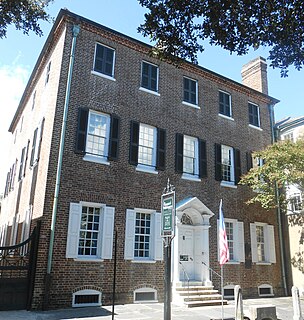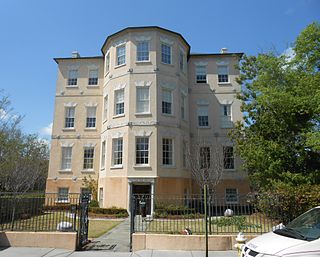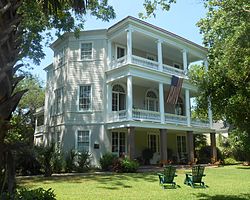
Robert Barnwell Rhett was an American politician who served as a deputy from South Carolina to the Provisional Confederate States Congress from 1861 to 1862, a member of the US House of Representatives from South Carolina from 1837 to 1849, and US Senator from South Carolina from 1850 to 1852. As a staunch supporter of slavery and an early advocate of secession, he was a "Fire-Eater".

Drayton Hall is an 18th-century plantation located on the Ashley River about 15 miles (24 km) northwest of Charleston, South Carolina, and directly across the Ashley River from North Charleston, west of the Ashley in the Lowcountry. An example of Palladian architecture in North America and the only plantation house on the Ashley River to survive intact through both the Revolutionary and Civil wars, it is a National Historic Landmark.

James Louis Petigru was an American lawyer, politician, and jurist in South Carolina. He is best known for his service as the Attorney General of South Carolina, his judicial work that played a key role in the recodification of the state's law code. He was also known for opposing nullification and, in 1860, state secession.

The Miles Brewton House is a National Historic Landmark residential complex located in Charleston, South Carolina. It is one of the finest examples of a double house in Charleston, designed on principles articulated by Andrea Palladio. Located on two acres, its extensive collection of dependencies makes it one of the most complete Georgian townhouse complexes in America. The house was built ca. 1765-1769 for Miles Brewton, a wealthy slave trader and planter.

The large, neoclassical Simmons-Edwards House is a Charleston single house built for Francis Simmons, a Johns Island planter, about 1800. The house, located at 14 Legare St., Charleston, South Carolina, is famous for its large brick gates with decorative wrought iron. The gates, which were installed by George Edwards and which bear his initials, include finials that were carved to resemble Italian pinecones. They are frequently referred to as pineapples by locals, and the house is known popularly as the Pineapple Gates House.

The William Blacklock House is a historic house at 18 Bull Street in Charleston, South Carolina. A National Historic Landmark, this brick house, built in 1800 for a wealthy merchant, is one of the nation's finest examples of Adamesque architecture. It is now owned by the College of Charleston, housing its Office of Alumni Relations.

The Fireproof Building, also known as the County Records Building, is located at 100 Meeting Street, at the northwest corner of Washington Square, in Charleston, South Carolina. Completed in 1827, it was the most fire-resistant building in America at the time, and is believed to be the oldest fire-resistant building in America today.

The William Lowndes Yancey Law Office is located at the corner of Washington and Perry Streets in Montgomery, Alabama. It served as the law offices for one of the South's leading advocates of secession from the United States, William Lowndes Yancey, from 1846 until his death in 1863. He joined with John A. Elmore to form a legal firm after his resignation from Congress on 1 September 1846. Yancey wrote Alabama's Ordinance of Secession after the election of Abraham Lincoln and subsequently served as the Confederacy's Commissioner to England and France.

Beaufort Historic District is a historic district in Beaufort, South Carolina. It was listed on the National Register of Historic Places in 1969, and was declared a National Historic Landmark in 1973.

The Heyward-Washington House is a historic house museum at 87 Church Street in Charleston, South Carolina. Built in 1772, it was home to Thomas Heyward, Jr., a signer of the United States Declaration of Independence, and was where George Washington stayed during his 1791 visit to the city. It is now owned and operated by the Charleston Museum. Furnished for the late 18th century, the house includes a collection of Charleston-made furniture. Other structures include the carriage shed and 1740s kitchen building.

Edward Brickell White, also known as E. B. White, was an architect in the United States. He was known for his Gothic Revival architecture and his use of Roman and Greek designs.

The Robert William Roper House is an historic house at 9 East Battery in Charleston, South Carolina. It was built on land purchased in May 1838 by Robert W. Roper, a state legislator from the parish of St. Paul's and a prominent member of the South Carolina Agricultural Society, whose income derived from his position as a cotton planter and slave holder. The house is an outstanding example of early 19th Century Greek Revival architecture, built on a monumental scale. Although there are now two houses between Roper House and White Point Garden to the south, for a decade after its construction nothing stood between the house and the harbor beyond, making it the first and most prominent house to be seen by visitors approaching Charleston by sea.

St. Philip's Church is an historic church at 142 Church Street in Charleston, South Carolina. Its National Historic Landmark description states: "Built in 1836, this stuccoed brick church features an imposing tower designed in the Wren-Gibbs tradition. Three Tuscan pedimented porticoes contribute to this design to make a building of the highest quality and sophistication." On November 7, 1973, it was added to the National Register of Historic Places and designated a National Historic Landmark.

The Gov. William Aiken House was built in 1820 at 48 Elizabeth Street, in the Wraggborough neighborhood of Charleston, South Carolina. Despite being known for its association with Gov. William Aiken, the house was built by John Robinson after he bought several lots in Mazyck-Wraggborough in 1817. His house was originally configured as a Charleston single house with entrance to the house from the south side along Judith Street. The house is considered to be the best preserved complex of antebellum domestic structures in Charleston. It was the home of William Aiken, Jr., a governor of South Carolina, and before that the home of his father, the owner of South Carolina Canal and Railroad Company, William Aiken.

Magnolia Cemetery is a historic rural cemetery in Charleston, South Carolina. The first board for the cemetery was assembled in 1849 with Edward C. Jones as the architect. It was dedicated in 1850; Charles Fraser delivered the dedication address. It was listed on the National Register of Historic Places as a Historic District in 1978.

Edward Culliatt Jones was an American architect from Charleston, South Carolina. A number of his works are listed on the U.S. National Register of Historic Places, and two are further designated as U.S. National Historic Landmarks. His works include the following :

The Sword Gate House is a historic house in Charleston, South Carolina. Built in stages, the main portion of the house is believed to have been built around 1803, possibly by French Huguenots James LaRoche and J. Lardent. The house replaced a simpler house that was shown on a plat in 1803.

The Middleton-Pinckney House is a historic three-story home built on a raised basement at 14 George Street, Charleston, South Carolina in the Ansonborough neighborhood. Frances Motte Middleton began construction of the house in 1796 after purchasing a second lot adjacent to one bought by her father on George St. The house was completed by her and her second husband, Maj. Gen. Thomas Pinckney, whom she married in 1797.

The Hanckel-Barclay House, also known as Chestnut Hill, is a historic house in the Dunn's Rock community near Brevard, Transylvania County, North Carolina, bordered by the French Broad River and US Highway 276. The house was listed on the National Register of Historic Places in 1999.

The Rhett House Inn, is a historic Inn at 1009 Craven Street, Beaufort, South Carolina. It is significant as the home of Thomas Moore Rhett and his wife, Caroline Barnwell, who were early pioneers in South Carolina in the 1800s. The Inn is in the Point neighborhood, which is part of the Beaufort Historic District. Today, the Rhett House Inn serves as a Four Diamond bed and breakfast Inn.
























